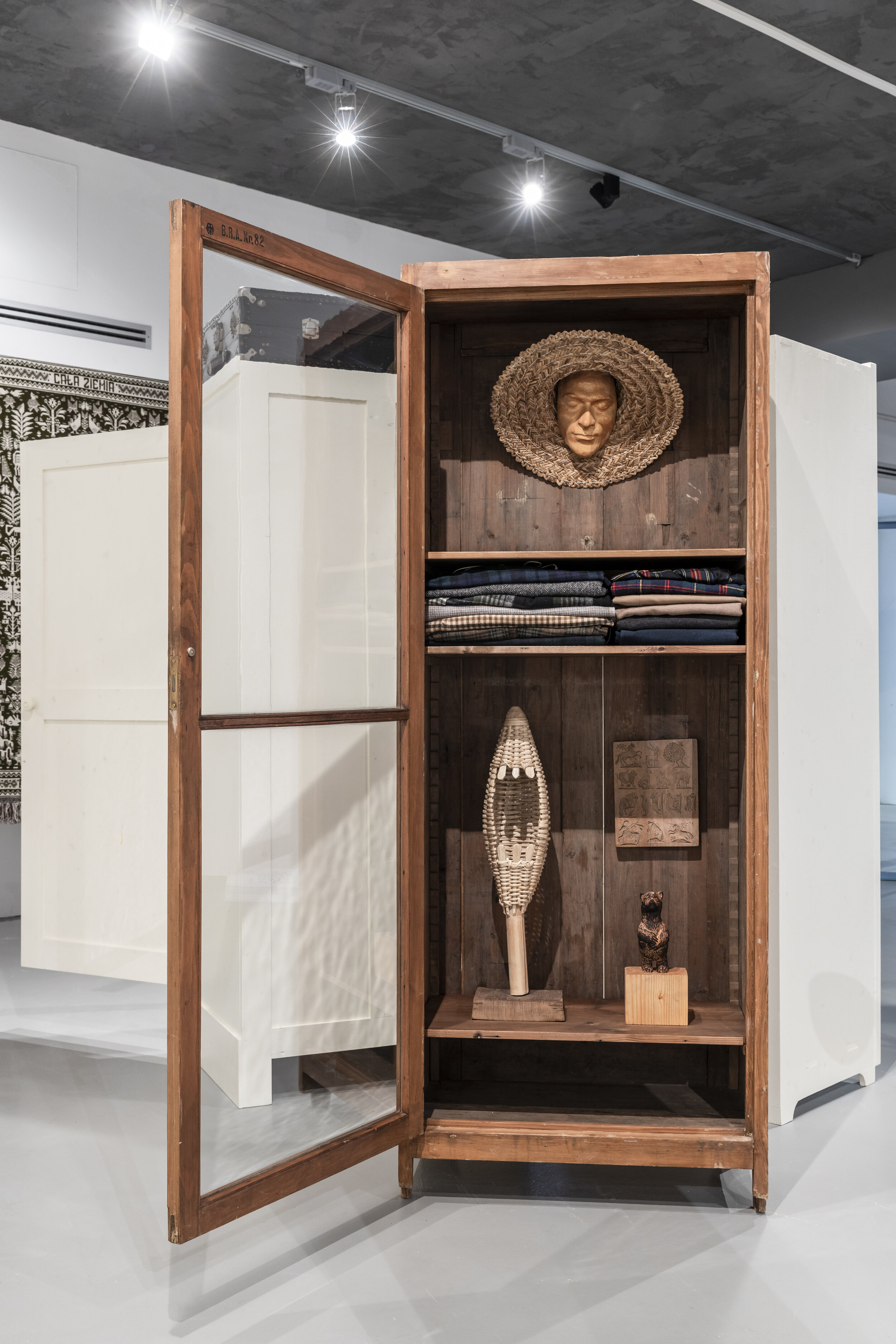
Paloma Varga Weisz
*1966, Germany
lives in and works in Düsseldorf, Germany
EN
The body of a man hung from the ceiling of the Sala Trenker exhibition space. The sculpture was created by Paloma Varga Weisz. At first sight, the artwork looked rather historical, probably because of the material used (wood) and the body’s joints. However, the artist found inspiration in a recent photograph of a climber in the Swiss Alps. The man hung helplessly — in the ropes, as it were, held by his harness. His joints were limp, like those of a life-sized puppet on strings. His expression seemed forlorn, with an aura of vulnerability. He was literally hanging in the air and was condemned to immobility. This hanging man is an example of the incredible precision in the craftsmanship and artistic language of Paloma Varga Weisz. Indeed, the artist sculpts her works with her own hands, something which is quite unusual these days, when most artists rely on a team of assistants. If her artworks appear medieval and fairytale-like, however, the artist is quick to warn us: “I hate the words ‘mythical’ or ‘fairytale-like, because none of my sculptures are. My inspiration comes from other sources, like newspapers or porn magazines, not from a fairytale.”
The artist was also present in the exhibition with four cabinets and a series or watercolours. The slender cabinets, coming in an upright format, are entirely in keeping with the idea of the Wunderkammer (cabinet of wonders). The artist used old wardrobes for the purpose, which originally held treasures on its shelves and even in the doors. Now her wardrobes serve as work catalogues, in which her hand-carved wooden figures as well as other objects are placed to enter into a dialogue with each other. In contrast, the delicate watercolours also served as independent sketches, poetic comments on the artist’s universe.
IT
Il corpo di un uomo pende dal soffitto dello spazio espositivo. A prima vista il materiale utilizzato e le giunture del corpo farebbero pensare a un’opera di ispirazione medievale. Tuttavia, Paloma Varga Weisz (*1966, Germania) si è ispirata a una fotografia storica di Toni Kurz, il cui tragico incidente e la cui drammatica lotta tra la vita e la morte sulla parete nord dell’Eiger nelle Alpi svizzere nel 1936 divenne uno dei primi eventi mediatici all’inizio della gara nazionale delle prime salite alpine. L’uomo, appeso a delle corde, è immobile e impo-tente, le sue articola-zioni sono flessibili come fosse un burat-tino a grandezza naturale, mentre la sua espressione sembra abban-donata e vulnerabile. Sospeso in aria, è con-dannato all’immobilità.
Quest’opera ben racconta dell’incredibile precisione del linguaggio artigianale e artistico di Paloma Varga Weisz. È lei stessa infatti che scolpisce e lavora le proprie opere, cosa insolita oggi, dove la maggior parte degli artisti si affida di solito a un team di assistenti. Ma se le sue opere sembrano di fattura medio-evale e spaventose, Varga Weisz ci ammonisce: “Odio le parole “mitico” o “fiabesco”, perché nessuna delle mie sculture lo è. La mia ispirazione viene da altre fonti, come giornali o riviste porno, non da una fiaba”.
L’artista, inoltre, è presente anche con quattro armadi e una serie di acquerelli. Gli armadi, che si slanciano alti e sottili, sono delle vere e proprie Wunderkammer, dispositivi originariamente pensati infatti come armadi dove riporre i propri tesori sugli scaffali e persino all’interno delle ante. Gli armadi di Paloma Varga Weisz funzionano come un catalogo di opere, che riprende e cita diverse figure tipiche. In contrasto con gli oggetti presenti sulle mensole, i delicati acquerelli rappresentano schizzi visivi che commentano poeticamente l’universo dell’artista.
DE
Im Ausstellungsraum des Trenker-Saals hängt der Körper eines Mannes von der Decke. Die Skulptur stammt von Paloma Varga Weisz (*1966, Deutschland). Auf den ersten Blick würde das verwendete Material und die Gelenke des Körpers auf ein historisches Werk hindeuten. Inspiriert wurde Paloma Varga Weisz durch ein historisches Foto von Toni Kurz, dessen tragischer Absturz und Todeskampf an der Eiger-Nordwand 1936 zu einem der ersten medialen Ereignisse des beginnenden nationalen Wettlaufs alpiner Erstbesteigungen wurde. Der Mann hängt hilflos am Riemen in den Seilen, seine Gelenke sind weich, seine Gliedmaßen scheinen wie jene einer lebensgroße Marionette an Fäden zu hängen. Sein Ausdruck wirkt verloren, und er hat eine Aura der Verletzlichkeit. Er hängt buchstäblich in der Luft, ist zur Unbeweglichkeit verurteilt.
Dieses Werk ist Zeuge der unglaublichen Präzision der handwerklichen und künstlerischen Sprache von Paloma Varga Weisz. Tatsächlich fertigt die Künstlerin ihre Werke selbst an, was heutzutage ungewöhnlich ist, da die meisten Künstler sich in der Regel auf ein Team von Assistenten oder eine externe Produktion verlassen. Und wenn ihre Kunstwerke mittelalterlich und märchenhaft wirken, so warnt uns Varga Weisz: „Ich hasse die Worte ‚mythisch‘ oder ‚märchenhaft‘, denn keine meiner Skulpturen ist es. Meine Inspiration kommt aus anderen Quellen, wie Zeitungen oder Pornoheften, nicht aus einem Märchen“.
Die Künstlerin ist auch mit vier Kabinetten und einer Serie von Aquarellen vertreten. Die schlanken, hochformatigen Kabinette entsprechen ganz der Idee der Wunderkammer. Varga Weisz verwendet hierbei alte Kleiderschränke, in denen ursprünglich Schätze in den Regalen und sogar in den Türen verstaut wurden. Nun fungieren ihre Schränke als Werkkataloge, in denen sie ihre handgeschnitzten Figuren aus Holz sowie andere Gegenstände in Dialog zueinander setzt. Demgegenüber stehen die zarten Aquarelle als eigenständige Skizzen, die das Universum der Künstlerin poetisch kommentieren.


